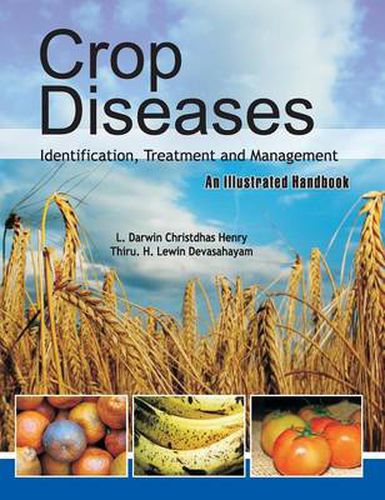Readings Newsletter
Become a Readings Member to make your shopping experience even easier.
Sign in or sign up for free!
You’re not far away from qualifying for FREE standard shipping within Australia
You’ve qualified for FREE standard shipping within Australia
The cart is loading…






Plant diseases are among the important factors that are responsible for causing yield loss in crop production. The loss due to diseases alone is estimated to be around 26 per cent. Diseases may attack at any stage of the standing crop, from seedlings till maturity of the crop. They may affect different parts of the plants, such as foliage, stem, root, flowers or seed and cause various types of symptoms, while the diseases such as wilt affect the entire plant. All these ultimately result in the reduction of yield and poor quality of the produce. Further, many pathogens continue to attack the stored grains and stored produce, and cause spoilage. To save the crops from diseases caused by pathogens and thereby to increase crop production, it is imminent that diseases have to be controlled by any means. To adopt various strategies for the control of pathogens, one should have some basic knowledge about the symptoms produced by the pathogens, their life cycle, mode of survival and spread, and the stage at which the host is most vulnerable to attack by the pathogens. Most of the cultivated varieties of different crops are susceptible to one disease or another, while some others are susceptible to many diseases. Even resistant cultivars of some of the crop species may become susceptible to some specific diseases in course of time as a result of development of new physiologic races of the pathogen by hybridization or natural mutation or when the environmental conditions are highly favorable for the pathogen and not quite favorable for the host. In this book the authors have given a detailed account of the major diseases of important field crops and horticultural crops, and their management. The text is substantiated with many hand-drawn illustrations, which are of excellent quality and in fact it is the highlight of the book. A on important edible mushrooms commonly grown in India, methods of cultivation of different mushrooms, diseases and pests attacking mushroom beds and mushrooms is also included in the book. This may be quite useful to emerging entrepreneuThe book, which has been compiled as per the undergraduate syllabus of agricultural institutions, will also be of use to postgraduate students and to those working in the department of agriculture.
$9.00 standard shipping within Australia
FREE standard shipping within Australia for orders over $100.00
Express & International shipping calculated at checkout
Plant diseases are among the important factors that are responsible for causing yield loss in crop production. The loss due to diseases alone is estimated to be around 26 per cent. Diseases may attack at any stage of the standing crop, from seedlings till maturity of the crop. They may affect different parts of the plants, such as foliage, stem, root, flowers or seed and cause various types of symptoms, while the diseases such as wilt affect the entire plant. All these ultimately result in the reduction of yield and poor quality of the produce. Further, many pathogens continue to attack the stored grains and stored produce, and cause spoilage. To save the crops from diseases caused by pathogens and thereby to increase crop production, it is imminent that diseases have to be controlled by any means. To adopt various strategies for the control of pathogens, one should have some basic knowledge about the symptoms produced by the pathogens, their life cycle, mode of survival and spread, and the stage at which the host is most vulnerable to attack by the pathogens. Most of the cultivated varieties of different crops are susceptible to one disease or another, while some others are susceptible to many diseases. Even resistant cultivars of some of the crop species may become susceptible to some specific diseases in course of time as a result of development of new physiologic races of the pathogen by hybridization or natural mutation or when the environmental conditions are highly favorable for the pathogen and not quite favorable for the host. In this book the authors have given a detailed account of the major diseases of important field crops and horticultural crops, and their management. The text is substantiated with many hand-drawn illustrations, which are of excellent quality and in fact it is the highlight of the book. A on important edible mushrooms commonly grown in India, methods of cultivation of different mushrooms, diseases and pests attacking mushroom beds and mushrooms is also included in the book. This may be quite useful to emerging entrepreneuThe book, which has been compiled as per the undergraduate syllabus of agricultural institutions, will also be of use to postgraduate students and to those working in the department of agriculture.